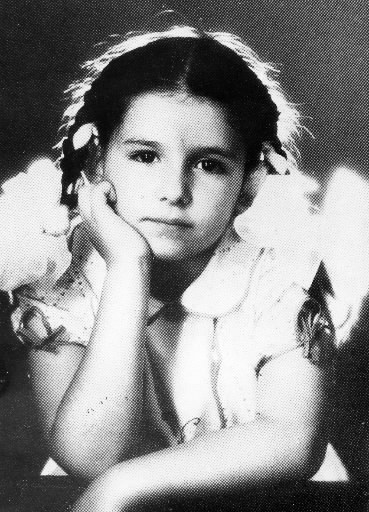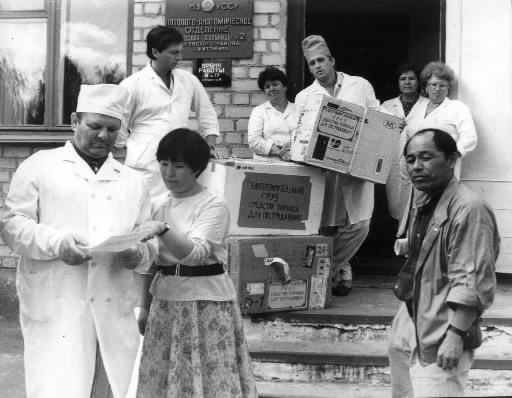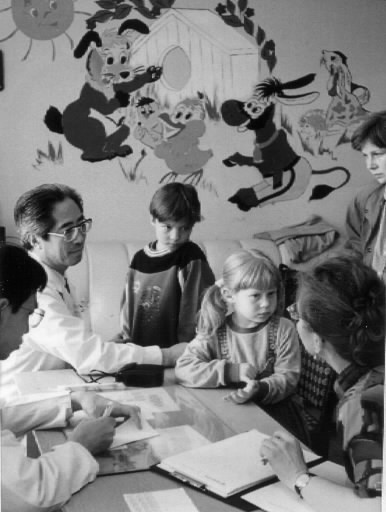History of Hiroshima: 1945-1995 (Part 27, Article 2)
Mar. 18, 2013
Medical contributions
by Yoshifumi Fukushima, Staff Writer
Note: This article was originally published in 1995.
Human intelligence has created a “monster”: radioactive material, though hazardous, cannot be eradicated. Moreover, some radioactive materials retain their radioactivity semi-permanently. “Nuclear waste,” which is the inevitable byproduct of operating a nuclear power plant, is also radioactive material. Currently, such radioactive waste can only be buried in the ground. While Japan has a whole fleet of nuclear power plants, the problem of nuclear waste disposal has hardly been discussed.
The accident involving the Chernobyl nuclear reactor seared the horror of radiation on human history. The city of Hiroshima, and other parts of Japan, have continued to provide medical support for the area affected by the Chernobyl catastrophe, which has slowly wrecked people’s lives. How should human beings, as well as the A-bombed city of Hiroshima, which experienced the disaster of the atomic bombing and denounced its horror, confront this “invisible” and “inerasable” monster? Amid efforts seeking ways to face this monster, the 50th anniversary of the atomic bombing now looms.
Earnest medical efforts ease suffering: Citizens’ group provides support to Chernobyl
A letter from the Bobkins family said that it happened on their happiest day together, the day they moved into a new house. That evening, they invited guests over and were feeling blissful about life in their new home.
Then, that night, the awful accident occurred. The area around the Chernobyl plant was evacuated, and their new life vanished, like a dream.
Still, for many years, they believed they would be able to return to the land where they were born.
These thoughts were expressed in a letter from the Bobkins family, who live in Ukraine, which had been part of the former Soviet Union, to a mother in Japan. The family had been residents of Pripyat City, a town made up of workers for the Chernobyl nuclear power plant, located within 5 kilometers of the plant. The three-member family—father, mother, and daughter—were among those affected when the worst nuclear accident in history suddenly struck the town on April 26, 1986.
The letter began by addressing Japanese citizens as people who suffered the world’s first tragedy from nuclear war. It then explained that the writer was a mother, too, who was wracked with worry over her child’s health because of the horrific accident.
A citizens’ group called the “Association to Help Chernobyl, Chubu-District, Japan,” which stepped forward to provide medical support to the region, called for those in the affected area and people in Japan to exchange letters. The letter from the Bobkins family was part of this exchange.
A number of other letters were steeped in the writers’ distress. One letter said that children had begun to fall ill and were suffering from anemia and liver ailments—from “a cluster of diseases.” Another letter said that their hearts ached at having to continue feeding their children food that was contaminated with radiation.
The cries of these residents of the affected area, who are suffering gravely as a result of a single nuclear accident, move the heart of the reader.
The first time two members of the Association to Help Chernobyl, Chubu-District, Japan were dispatched to the region to make firsthand observations, in the summer of 1986, they walked around the highly-contaminated area and experienced a shock. A device they were using to measure the level of radiation indicated that the radioactivity was 80 times higher than that typically found in Japan. When these members, with the permission of local authorities, moved closer to the nuclear power plant, the needle on their device shook violently. The unseen radioactivity had permeated the grain-growing region of Ukraine.
Because the grass was contaminated, milk produced by grass-fed cows was not fit to drink. A provincial hospital for children in Zhytomyr did not even own a microscope. The Association to Help Chernobyl saw which direction their relief efforts should take. Soliciting donations, they were able to send one ton of powdered milk to the affected area. This was the group’s first delivery of relief supplies.
At the time, it was said that relief supplies would end up on the black market due to the systemic disorder in the former Soviet Union, even when the goods were shipped directly to the area. So the members of the Association to Help Chernobyl, in cooperation with the local people, cleared a route for their relief activities. Powdered milk is now sent annually to the region at the end of each year. Found on the outside of the milk cans are the messages and photos of those who donated money for the milk, so that their “faces” can be seen.
Masaharu Kawata, 55, a teaching assistant at Nagoya University, is the secretary-general of the group. “I feel the expectations they have for the A-bombed nation,” he said. The group often receives requests for medical data, as well as requests to help local residents visit Japan to undergo medical treatment. But, first and foremost, they hope to promote medical preparedness in the area. Thus, the group invites local doctors to Japan to enable them to learn about the research that has been conducted on radiation and study medical technology at hospitals in Nagoya and Hiroshima. To date, 12 doctors have come to Japan for this purpose. After their training, the group presents them with medical equipment needed by the doctors back home.
An ultrasound machine, an incubator, anticancer drugs... Total costs of the medical equipment and medical supplies contributed by the group over the past five years have amounted to 120 million yen. Providing assistance that will help the local people to become independent is, they believe, the proper form of support.
Forty percent of these costs have been covered by a subsidy from the Postal Savings for Voluntary Aid, but the remaining amount comes from small donations. Kyoko Tomura, 46, the first leader of the group, said, “Things were rough at the beginning, and we wanted to end our involvement once the government began to provide support. But when you hear the voices of those who are suffering...” Ms. Tomura added, “But our relief efforts can only have a real impact when the recipients themselves feel the courage to live their lives. It’s the link between our hearts that helps sustain them.”
In the group’s second year since its founding, a woman named Nina, who works as a teacher in the village of Makarevich, sent 50 pictures made by her students. The drawings contained such scenes as a nuclear power plant in flames, ferociously spewing smoke; dolls and toys scattered in the yard of an abandoned home; and a girl lying on a bed, suffering from a nosebleed.
At school, her students would murmur to Nina: “I had another nosebleed” or “I got dizzy and I felt sick.” At the time of the nuclear accident, the reality of the radioactive contamination was not conveyed to the local residents. How could she comfort these children? Nina’s eldest son was also suffering from a thyroid disorder.
“The pictures were shocking, but they also empowered us to continue our relief efforts,” Professor Kawata said.
Last summer, Nina paid a visit to Hiroshima. She came to Japan at the invitation of a woman in Kanazawa City, Ishikawa Prefecture, a member of the Association to Help Chernobyl and, like Nina, a teacher. She and her students extended this invitation after ties were forged through correspondence and pictures between the two groups of students. After hearing the experience of an A-bomb survivor, Nina thought, “Even now, 49 years after the end of the war, these mothers cry out for their children who were killed in the atomic bombing. Mothers in Ukraine are crying for their children, too.” There emerged a heartfelt connection between the A-bombed city of Hiroshima and the nuclear-affected area of Ukraine.
Nina also attended a recitation play entitled “Kono Kotachi no Natsu” (“The Summer of These Children”), which conveys the A-bomb experiences of Hiroshima and Nagasaki, and received the Russian translation of the script. After returning to Ukraine, she sent a letter to Hiroshima to say that her students were now performing the play.
Once, the chief editor of a newspaper company in Zhytomyr, a contact point for the Association to Help Chernobyl, sent the following words to the group: “Let Japan, with its bitter experience of the atomic bombing, and nuclear-affected sufferers in Ukraine share their experiences and talk about the danger of atomic power.”
Medical assistance is a form of support for catastrophes that have already occurred. How, then, do those involved in relief activities confront nuclear power plants, the source of that radiation-wrought damage?
“As there are a variety of views on nuclear energy,” said Professor Kawata, “we’re not going, as a group, to frame a response with respect to this issue. For us, ‘humanitarianism’ is the key factor we share.” In the past, however, the group has twice issued statements expressing opposition to nuclear energy. In 1991, when the emergency core cooling system of the Mihama Nuclear Power Plant in Fukui Prefecture began operating—the first time such a system went into operation in Japan—the group called on the Kansai Electric Power Company to cancel the restart of the power station. In 1993, the group appealed for the Ukrainian government to close nuclear reactors in operation in Chernobyl. On each occasion, they discussed the matter thoroughly, then reached the decision to act.
Shortly after Professor Kawata and others took up their activities, the former Soviet Union collapsed. Subsequently, goods were in short supply and prices soared. The price of powdered milk increased 3000-fold in two years. Thus, the milk that the group provided to a hospital has now become a very expensive “medicine.” In the economic turmoil following the independence of Ukraine, the independence of the radiation-affected sufferers, among others, is at an impasse.
Until the nuclear accident in Chernobyl, a radiation-related disaster had never drawn as much international attention as had been claimed. Nine years have now passed since the area was hit by the accident. According to Zhytomyr, the latest information includes “400,000 people still living within the contaminated area” and “of all meat and vegetables, only 30 or 40 percent of these food products are not contaminated.”
In 1993, Professor Kawata paid a visit to the affected area and headed for Pripyat, the town near the nuclear plant where the Bobkins family once lived.
The city was supposed to be “abandoned,” as the population of 130,000 within a radius of 30 kilometers from the nuclear plant, including the residents of Pripyat, was ordered to leave in a forced evacuation. But since that time about 2,500 people—all of them elderly—have returned to this area to take up residence again. The returnees have cultivated the fields and are drinking the well water. When night falls on this “vanished” town, which receives no official assistance, lamps are lit sparsely: one here, another there. The Ukrainian government has acquiesced when it comes to the decision of these people, saying that the elderly have the right to choose where they will die.
The “city of death” has also become a kingdom of wild animals. Driving on a snowy road, Professor Kawata accidently struck a deer and discovered a large lump, which he believed to be a tumor, protruding from the deer’s abdomen.
The “invisible monster” of radiation continues to wreak havoc on the animals, nature, and human beings. When it comes to providing relief, there is no end in sight.
Junod Society dispatches doctors 11 times, eager to investigate low-dose radiation exposure
The “Junod Society,” based in Fuchu City, Hiroshima, is another group providing assistance to Chernobyl. The founders of the group were moved by the actions of Dr. Marcel Junod, the Swiss doctor who made a devoted effort to bring medical supplies into the city one month after the atomic bombing of Hiroshima.
Since it was established in September 1988, the Junod Society has brought children and doctors from the nuclear-affected area to Japan, and, with cooperation from Hiroshima University’s medical department and Hiroshima University’s Research Institute for Radiation Biology and Medicine, has sent Japanese physicians to the area. They have made a strong effort, in particular, to dispatch doctors, taking this action 11 times to date.
“But the more specialized our contributions in the medical field become, the more distance I feel between these medical contributions and the citizens’ movement which has been supporting it,” said Hitoshi Kai, 45, chair of the group. This is because the group’s focus seems fixed on fundraising as the scale of the medical campaign has grown.
But physicians from Hiroshima who have been to Ukraine have observed that children there are suffering from thyroid cancer in unusually large numbers. In the aftermath of the atomic bombing, there was little incidence of thyroid cancer in Hiroshima. The doctors are eager to shed light on this new form of radiation damage, and despite the financial difficulties faced by the Junod Society, its members are struggling to support the doctors’ efforts.
Whether data on the atomic bombing, in which people were exposed to a massive dose of radiation at one time, can be useful in relief efforts for the victims of low-dose radiation exposure over a long duration—as in a nuclear accident—remains controversial. But it is nevertheless true that through the cooperation of private entities and their efforts in the medical field, medical standards in the radiation-affected area have begun to improve.
“It’s been seven years since we began our activities,” Mr. Kai said. “We’ve struggled to come this far.” Then he added: “If we can respond to the accident at Chernobyl by making contributions in the medical field, there’s a chance Hiroshima can become the world’s ‘relief center for nuclear damage.’” To that end, he also considers mutual support between volunteers and administrative bodies important.
(Originally published on July 23, 1995)










